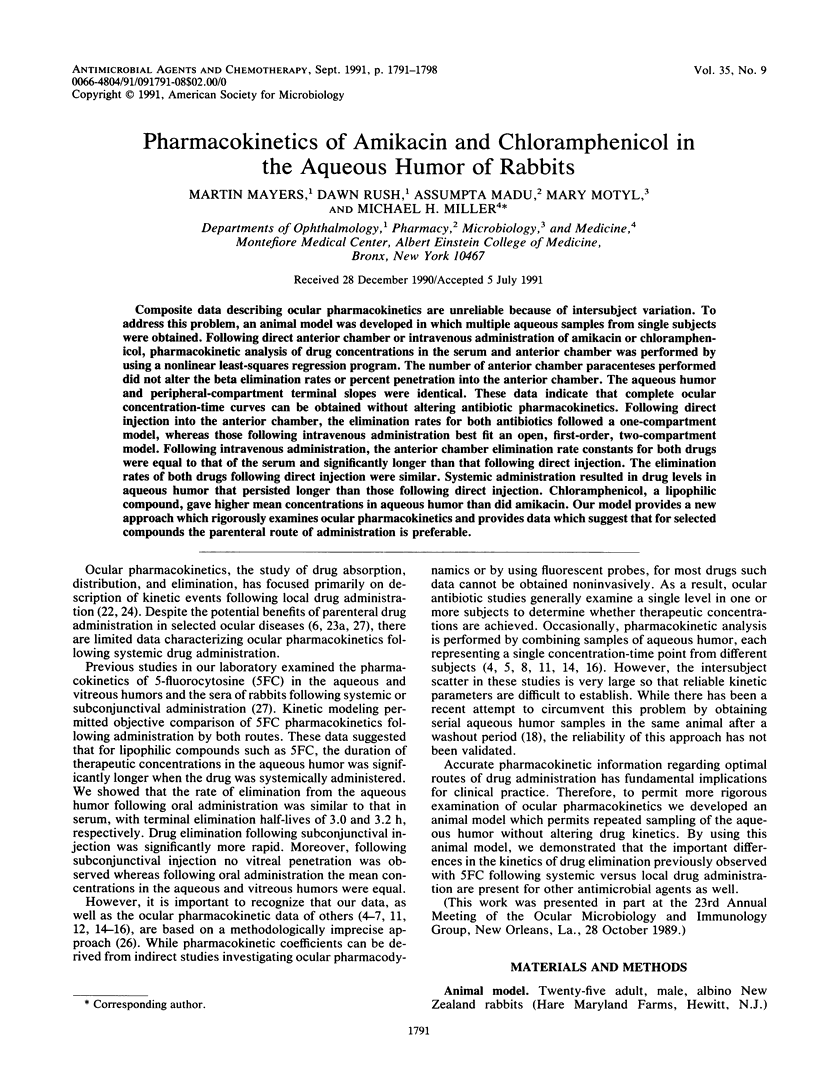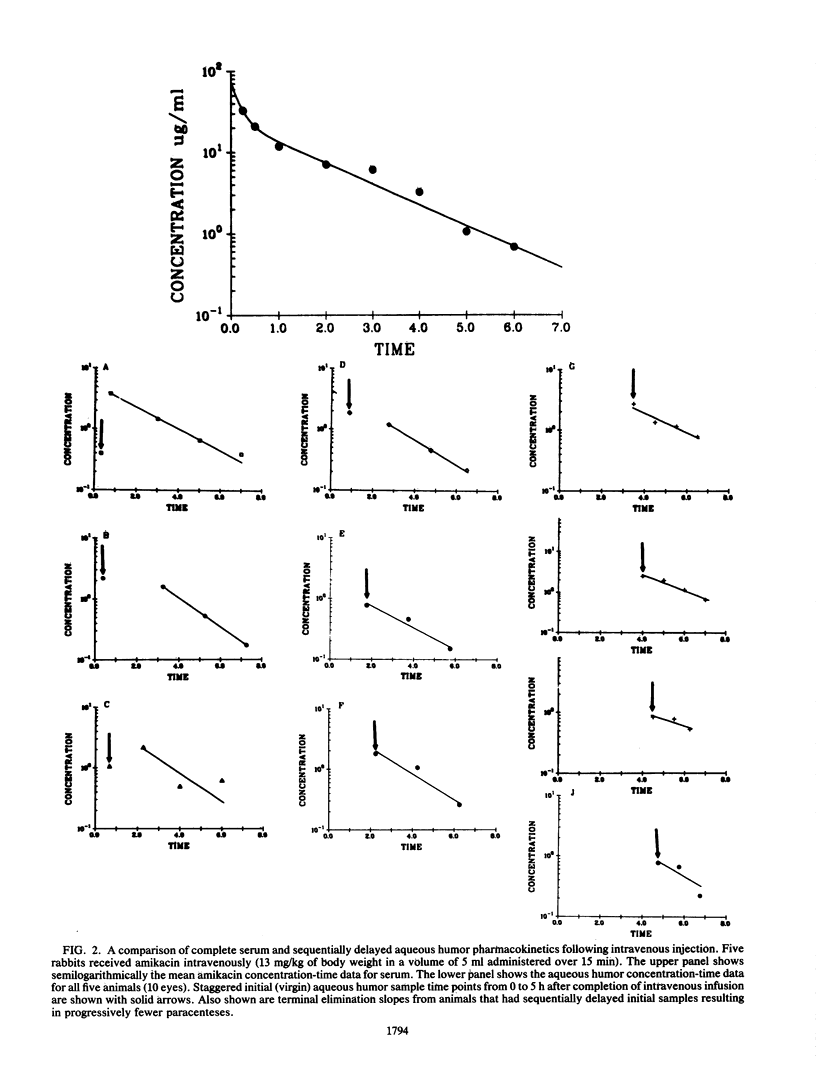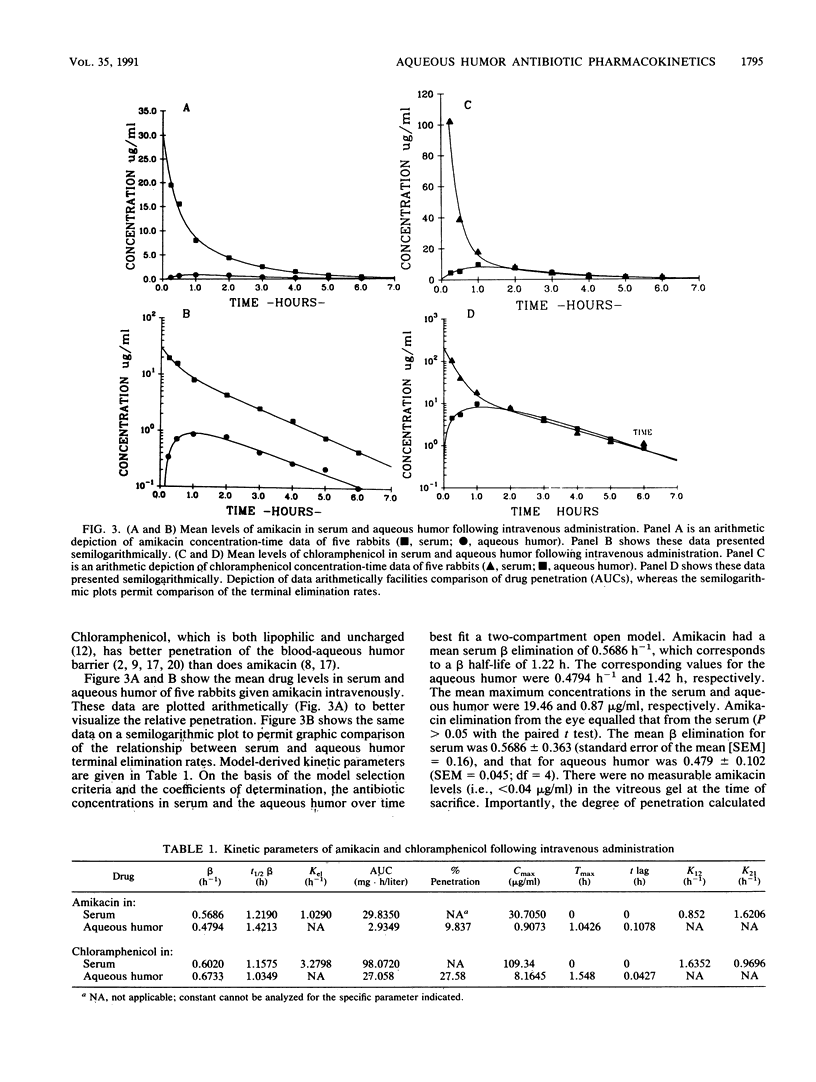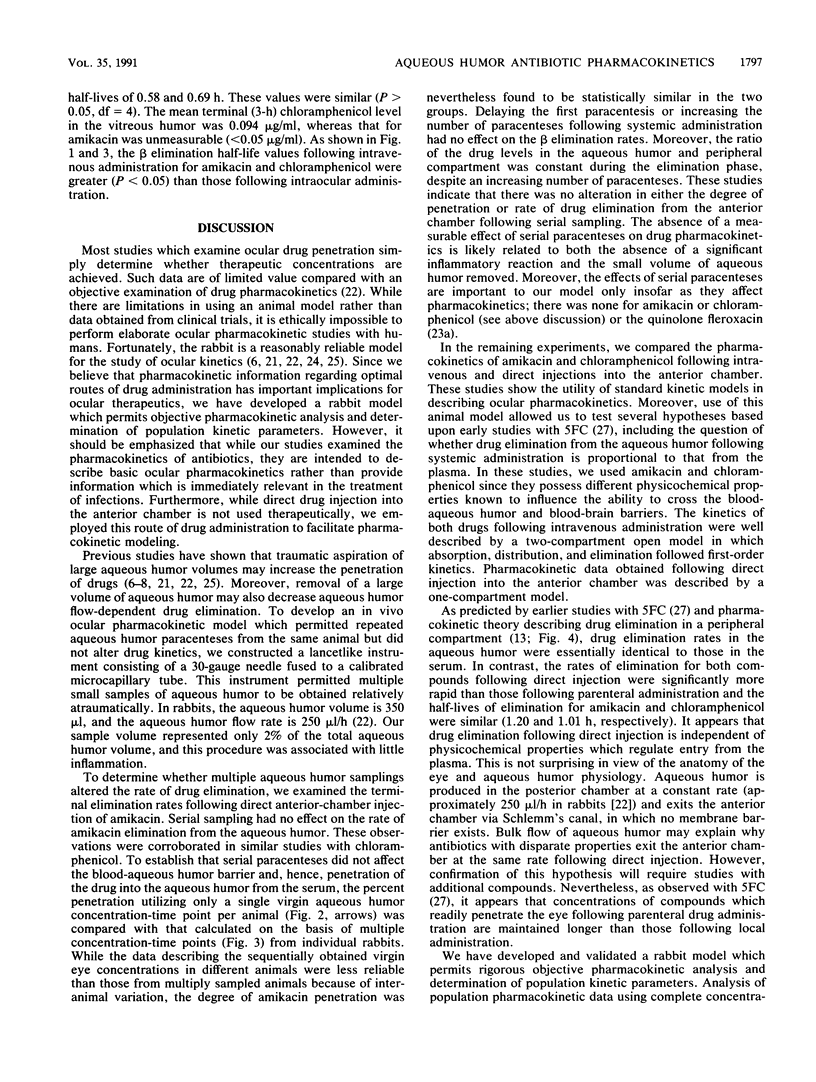Abstract
Composite data describing ocular pharmacokinetics are unreliable because of intersubject variation. To address this problem, an animal model was developed in which multiple aqueous samples from single subjects were obtained. Following direct anterior chamber or intravenous administration of amikacin or chloramphenicol, pharmacokinetic analysis of drug concentrations in the serum and anterior chamber was performed by using a nonlinear least-squares regression program. The number of anterior chamber paracenteses performed did not alter the beta elimination rates or percent penetration into the anterior chamber. The aqueous humor and peripheral-compartment terminal slopes were identical. These data indicate that complete ocular concentration-time curves can be obtained without altering antibiotic pharmacokinetics. Following direct injection into the anterior chamber, the elimination rates for both antibiotics followed a one-compartment model, whereas those following intravenous administration best fit an open, first-order, two-compartment model. Following intravenous administration, the anterior chamber elimination rate constants for both drugs were equal to that of the serum and significantly longer than that following direct injection. The elimination rates of both drugs following direct injection were similar. Systemic administration resulted in drug levels in aqueous humor that persisted longer than those following direct injection. Chloramphenicol, a lipophilic compound, gave higher mean concentrations in aqueous humor than did amikacin. Our model provides a new approach which rigorously examines ocular pharmacokinetics and provides data which suggest that for selected compounds the parenteral route of administration is preferable.
Full text
PDF







Selected References
These references are in PubMed. This may not be the complete list of references from this article.
- ABRAHAM R. K., BURNETT H. H. Tetracycline and chloramphenicol studies on rabbit and human eyes. AMA Arch Ophthalmol. 1955 Nov;54(5):641–659. doi: 10.1001/archopht.1955.00930020647002. [DOI] [PubMed] [Google Scholar]
- Abel R., Jr, Boyle G. L. Dissecting ocular tissue for intraocular drug studies. Invest Ophthalmol. 1976 Mar;15(3):216–219. [PubMed] [Google Scholar]
- Axelrod J. L., Kochman R. S. Cefamandole levels in primary aqueous humor in man. Am J Ophthalmol. 1978 Mar;85(3):342–348. doi: 10.1016/s0002-9394(14)77726-8. [DOI] [PubMed] [Google Scholar]
- Badenoch P. R., McDonald P. J., Coster D. J. Effect of inflammation on antibiotic penetration into the anterior segment of the rat eye. Invest Ophthalmol Vis Sci. 1986 Jun;27(6):958–965. [PubMed] [Google Scholar]
- Barza M., Kane A., Baum J. Pharmacokinetics of intravitreal carbenicillin, cefazolin, and gentamicin in rhesus monkeys. Invest Ophthalmol Vis Sci. 1983 Dec;24(12):1602–1606. [PubMed] [Google Scholar]
- Cunha-Vaz J. The blood-ocular barriers. Surv Ophthalmol. 1979 Mar-Apr;23(5):279–296. doi: 10.1016/0039-6257(79)90158-9. [DOI] [PubMed] [Google Scholar]
- Eiferman R. A., Stagner J. I. Intraocular penetration of amikacin. Iris binding and bioavailability. Arch Ophthalmol. 1982 Nov;100(11):1817–1819. doi: 10.1001/archopht.1982.01030040797018. [DOI] [PubMed] [Google Scholar]
- George F. J., Hanna C. Ocular penetration of chloramphenicol. Effects of route of administration. Arch Ophthalmol. 1977 May;95(5):879–882. doi: 10.1001/archopht.1977.04450050157020. [DOI] [PubMed] [Google Scholar]
- Goldman J. N., Broughton W., Javed H., Lauderdale V. Ampicillin, erythromycin and chloramphenicol penetration into rabbit aqueous humor. Ann Ophthalmol. 1973 Feb;5(2):147–156. [PubMed] [Google Scholar]
- Green K., MacKeen D. L. Chlorampenicol retention on, and penetration into, the rabbit eye. Invest Ophthalmol. 1976 Mar;15(3):220–222. [PubMed] [Google Scholar]
- Hanna C., Massey J. Y., Hendrickson R. O., Williamson J., Jones E. M., Wilson P. Ocular penetration of topical chloramphenicol in humans. Arch Ophthalmol. 1978 Jul;96(7):1258–1261. doi: 10.1001/archopht.1978.03910060084018. [DOI] [PubMed] [Google Scholar]
- Kitaura T., Tsukiai S., Arai S., Miyake K., Kimura M., Fukuchi H. Ocular pharmacokinetics of latamoxef and cefaclor in rabbits. Penetration into aqueous humor. J Pharmacobiodyn. 1988 Oct;11(10):694–699. doi: 10.1248/bpb1978.11.694. [DOI] [PubMed] [Google Scholar]
- Kluge R. M., Zimmerman T. The penetration of antistaphylococcal antibiotics into the aqueous humor of rabbits. Ann Ophthalmol. 1978 Sep;10(9):1248–1251. [PubMed] [Google Scholar]
- LEOPOLD I. H., NICHOLS A. C., VOGEL A. W. Penetration of chloramphenicol U.S.P. (chloromycetin) into the eye. Arch Ophthal. 1950 Jul;44(1):22–36. doi: 10.1001/archopht.1950.00910020025002. [DOI] [PubMed] [Google Scholar]
- Lesar T. S., Fiscella R. G. Antimicrobial drug delivery to the eye. Drug Intell Clin Pharm. 1985 Sep;19(9):642–654. doi: 10.1177/106002808501900905. [DOI] [PubMed] [Google Scholar]
- Mishima S. Clinical pharmacokinetics of the eye. Proctor lecture. Invest Ophthalmol Vis Sci. 1981 Oct;21(4):504–541. [PubMed] [Google Scholar]
- Sheiner L. B., Rosenberg B., Marathe V. V. Estimation of population characteristics of pharmacokinetic parameters from routine clinical data. J Pharmacokinet Biopharm. 1977 Oct;5(5):445–479. doi: 10.1007/BF01061728. [DOI] [PubMed] [Google Scholar]
- Walsh A., Haft D. A., Miller M. H., Loran M. R., Friedman A. H. Ocular penetration of 5-fluorocytosine. Invest Ophthalmol Vis Sci. 1978 Jul;17(7):691–694. [PubMed] [Google Scholar]
- Wingfield D. L., McDougal R. L., Roy F. H., Hanna C. Ocular penetration of amikacin following intramuscular injection. Arch Ophthalmol. 1983 Jan;101(1):117–120. doi: 10.1001/archopht.1983.01040010119022. [DOI] [PubMed] [Google Scholar]


